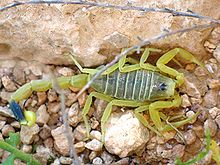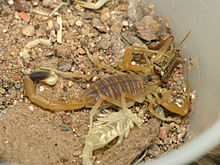- Deathstalker
-
Deathstalker Scientific classification Kingdom: Animalia Phylum: Arthropoda Subphylum: Chelicerata Class: Arachnida Order: Scorpiones Family: Buthidae Genus: Leiurus Species: L. quinquestriatus Binomial name Leiurus quinquestriatus
Hemprich & Ehrenberg, 1829The deathstalker (Leiurus quinquestriatus), is a species of scorpion, a member of the Buthidae family. It is also known as Palestine yellow scorpion,[1][2][3][4] Omdurman scorpion, Israeli desert scorpion and numerous other colloquial names, which generally originate from the commercial captive trade of the animal. To eliminate confusion, especially with potentially dangerous species, the scientific name is normally used to refer to them. The name Leiurus quinquestriatus roughly translates into English as "five-striped smooth-tail". Other species of the genus Leiurus are often referred to as "deathstalkers" as well.
Contents
Description
L. quinquestriatus is yellow in color, and measures 30–77 millimetres (1.2–3.0 in) long, with an average of 58 mm (2.3 in).[5]
Geographic range
L. quinquestriatus can be found in desert and scrubland habitats ranging from North Africa through to the Middle East. Countries where it lives include Algeria, Bahrain, Chad, Egypt, Ethiopia, Libya, Mali, Niger, Somalia, Sudan, Tunisia, Iraq, Israel, Jordan, Kuwait, Lebanon, Oman, Iran, Afghanistan, Pakistan, Qatar, Saudi Arabia, Syria, Turkey, Kazakhstan, United Arab Emirates, and Yemen.
Venom
The deathstalker is regarded as a highly dangerous species because its venom is a powerful cocktail of neurotoxins, with a low LD50.[6] While a sting from this scorpion is extremely painful, it normally would not kill an otherwise healthy adult human. However, young children, the elderly, or infirm (such as those with a heart condition or those who are allergic) would be at much greater risk. Any envenomation runs the risk of anaphylaxis, a potentially life-threatening allergic reaction to the venom. If a sting from Leiurus quinquestriatus does prove fatal, the cause of death is usually pulmonary edema.
The German pharmaceutical company Twyford[7] and the French pharmaceutical company Sanofi Pasteur[8] both make an antivenom intended for the treatment of deathstalker envenomations; additionally, the Antivenom and Vaccine Production Center in Riyadh also produces an antivenom.[9] However, even with antivenom treatment, envenomation by the deathstalker is considered a medical emergency as its venom is unusually resistant to treatment and typically requires large doses of antivenom.[10]
In the United States and other countries outside of the typical range of the deathstalker, there is the additional complicating factor that none of the existing antivenoms are approved by the Food and Drug Administration (or equivalent agencies) and are only available as investigational drugs. The US Armed Forces maintains an Investigational drug (IND) application[11] for the AVPC-Riyadh antivenom in the event of envenomation of soldiers in the Gulf War theater of operations, and the Florida Antivenin Bank maintains an IND application for Sanofi Pasteur's Scorpifav antivenom.[12]
One component of the deathstalker's venom, the peptide chlorotoxin, has shown potential for treating human brain tumors.[13] There has also been some evidence to show that other components of the venom may aid in the regulation of insulin and could be used to treat diabetes.
Neurotoxins in L. quinquestriatus venom include:
- Chlorotoxin
- Charybdotoxin
- Scyllatoxin
- Agitoxins type 1, 2 and 3
In captivity
They make hardy captives and feed readily on commercially available crickets. They tend to be a nervous and aggressive species, only recommended for the most experienced of arachnid keepers.[14][15][16][17]
Exotic pet trade
There is a considerable debate even among exotic pet owners about the ethics of keeping highly venomous arachnids such as L.quinquestriatus in captivity as exotic pets, because of concerns that inexperienced arachnid keepers may endanger themselves and because of the difficulties in obtaining antivenom in the event of envenomation. There is special concern among persons who keep venomous reptiles and arachnids as exotic pets regarding the marketing of L.quinquestriatus by pet stores, especially as the dangerous aspects are glorified whilst little evaluation is done with purchasers as to their experience with scorpions, highly venomous animals, or the potential risks of envenomation.[18] [19][20]
There are legal aspects regarding keeping of L.quinquestriatus. Like all Buthidae, it requires a licence under the UK's 1976 Dangerous Wild Animals act. Jurisdictions in the U.S. and Canada are increasingly including L.quinquestriatus in laws requiring permits to keep exotic animals or restricting ownership of "dangerous" exotics, and in some cases have outlawed the keeping of L.quinquestriatus save by licensed zoos and educational facilities. A number of state and provincial departments of fish and wildlife require exotic animal permits,[21] and a number of cities and municipal governments have prohibited their ownership in their bylaws prohibiting ownership of dangerous exotics.[22][23][24][25][26] Ownership of L.quinquestriatus may be broadly illegal in South Africa under similar laws prohibiting the ownership of dangerous animals.[27]
Despite the inherent danger in keeping such a highly venomous species as a pet and despite increasing legal restrictions on ownership, L.quinquestriatus is still readily available in the exotic pet trade including in pet stores.[28][29][30][31]
References
- ^ Minton, Sherman A. (1974). Venom diseases. Thomas. pp. 235. ISBN 9780398030513. http://books.google.com/books?id=aEtrAAAAMAAJ&q=%22palestine+yellow+scorpion%22&dq=%22palestine+yellow+scorpion%22&lr=&cd=13. Retrieved April 30, 2010.
- ^ The Staff of Cambridge Scientific Abstracts (1993). Entomology abstracts, Volume 24, Issues 10-12. Cambridge Scientific Abstracts. http://books.google.com/books?id=FdosAAAAMAAJ&q=%22palestine+yellow+scorpion%22&dq=%22palestine+yellow+scorpion%22&lr=&cd=6. Retrieved April 30, 2010.
- ^ Werness, Hope B. (2004). The Continuum encyclopedia of animal symbolism in art. Continuum International Publishing Group. pp. 476. ISBN 9780826415257. http://books.google.com/books?id=fr2rANLrPmoC&pg=PA360&dq=palestine+yellow+scorpion&cd=2#v=onepage&q=palestine%20yellow%20scorpion&f=false. Retrieved April 30, 2010.
- ^ Young, Mark (1998). The Guinness Book of World Records 1998. Bantam Books. pp. 768. ISBN 9780553578959. http://books.google.com/books?id=ZSyswNFqTycC&q=%22palestine+yellow+scorpion%22&dq=%22palestine+yellow+scorpion%22&lr=&cd=11. Retrieved April 30, 2010.
- ^ Zuhair S. Amr & Ratib El-Oran (1994). "Systematics and distribution of scorpions (Arachnida, Scorpionida) in Jordan". Italian Journal of Zoology 61 (2): 185–190. doi:10.1080/11250009409355881.
- ^ Lucian K. Ross (2008). "Leiurus quinquestriatus (Ehrenberg, 1828)" (PDF). The Scorpion Files. http://www.ntnu.no/ub/scorpion-files/l_quinquestriatus_info.pdf. Retrieved September 17, 2011.
- ^ "Scorpion Antivenom Twyford (North Africa)". MAVIN. Poison Centre Munich. January 15, 2010. http://www.toxinfo.org/antivenoms/productinfo/SCORPION_ANTIVENOM_TWYFORD__NORTH_AFRICA_.html. Retrieved December 1, 2010.
- ^ "Scorpifav". MAVIN. Poison Centre Munich. January 15, 2010. http://www.toxinfo.org/antivenoms/productinfo/SCORPIFAV.html. Retrieved December 1, 2010.
- ^ "Saudi National Antivenom and Vaccine Production Center". http://www.antivenom-center.com/products/index.htm. Retrieved December 1, 2010.
- ^ Goldfrank, Lewis R. (2006). Goldfrank's toxicologic emergencies. McGraw-Hill Professional. pp. 2064. ISBN 9780071479141. http://books.google.com/books?id=cvJuLqBxGUcC&pg=PA1624&dq=leiurus+quinquestriatus&hl=en&ei=jHPsTFyToZ0Hte7hmAI&sa=X&oi=book_result&ct=result&resnum=9&ved=0CEsQ6AEwCA#v=onepage&q=leiurus%20quinquestriatus&f=false. Retrieved November 23, 2010.
- ^ Eric A. Shalita & Ryan D. Wells (2007). "Treatment of yellow scorpion (Leiurus quinquestriatus) sting: a case report". Journal of the American Pharmacists Association 47 (5): 616–619. doi:10.1331/JAPhA.2007.07051. PMID 17848352.
- ^ "Antivenom: Species Covered". Miami-Dade Fire Rescue Department. January, 2009. http://www.miamidade.gov/mdfr/library/09-January_Antivenom_Species_Covered.pdf. Retrieved December 1, 2010.
- ^ Liliana Soroceanu, Yancey Gillespie, M. B. Khazaeli & Harald Sontheimer (1998). "Use of chlorotoxin for targeting of primary brain tumors". Cancer Research 58 (21): 4871–4879. PMID 9809993. http://cancerres.aacrjournals.org/cgi/content/abstract/58/21/4871.
- ^ http://www.offbeatpets.com/?p=301
- ^ http://www.arachnoboards.com/ab/showthread.php?t=74062
- ^ http://www.freewebs.com/scorpionsunlimited/caresheets.htm
- ^ http://gregsdragons.wordpress.com/2009/10/17/leiurus-quinquestriatus-deathstalker-scorpion/
- ^ http://www.venomousreptiles.org/forums/Experts/36480
- ^ Rubio, Manny (2008). Scorpions: Everything about Purchase, Care, Feeding, and Housing. Barron's Educational Series. pp. 112. ISBN 9780764139819. http://books.google.com/books?id=N05C7CJUscoC&printsec=frontcover&dq=manny+rubio&hl=en&ei=BGzsTO7oM4_Wngf11u3gAQ&sa=X&oi=book_result&ct=result&resnum=1&ved=0CCMQ6AEwAA#v=onepage&q=deathstalker&f=false. Retrieved November 23, 2010.
- ^ http://www.arachnoboards.com/ab/showthread.php?t=261
- ^ http://www.vtfishandwildlife.com/.%5Clibrary%5CForms_and_Applications%5CImportation_%20Application/Species/Appendix-%20Exceptions_to_the_Unrestricted_Wild_Animal_List.pdf
- ^ http://www.townofmorrison.org/OrdinancesZoning/Ordinance0702.pdf
- ^ http://www.thevillageofpulaski.org/pdf/ordinance/chapter30.pdf
- ^ http://www.ci.green-bay.wi.us/codebook/chp8.pdf
- ^ http://www.brooklynshelter.org/AnimalOrdinances.pdf
- ^ http://www.townofrockland.org/Documents/Animal_Ordinance_Draft_200801.doc
- ^ http://www.sareptiles.co.za/forum/viewtopic.php?f=19&t=13782
- ^ http://www.arachnoboards.com/ab/showthread.php?t=34651
- ^ http://pawild.net/alanherper/show_con.php?p_id=25
- ^ http://visualadvance.com/invertcare/caresheets/scorpions/Leiurus/Leiurusquinquestriatus.html
- ^ http://www.edmontonreptiles.com/forum/showthread.php?t=9799
External links
- Leiurus quinquestriatus, WikiPets
Categories:- Scorpions
- Fauna of Pakistan
- Animals described in 1829
Wikimedia Foundation. 2010.


